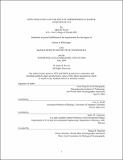Iron limitation and the role of Siderophores in marine Synechococcus
Author(s)
Rivers, Adam R. (Adam Reid)
DownloadFull printable version (8.346Mb)
Other Contributors
Woods Hole Oceanographic Institution.
Advisor
Eric A. Webb.
Terms of use
Metadata
Show full item recordAbstract
Marine cyanobacteria in the genus Synechococcus are widely distributed and contribute significantly to global primary productivity. In many parts of the ocean their growth is limited by a lack of iron, an essential nutrient that is virtually insoluble in seawater. To overcome this, Synechococcus have evolved a number of strategies to acquire iron. Gene distribution, metagenomics and a novel immunological flow cytometry assay in the Costa Rica Upwelling Dome were used to estimate the importance of Fe stress. Genomic and metagenomic measures suggest that iron limitation is, paradoxically, more severe in coastal and upwelling areas than in the open ocean, where iron is less abundant. A serological assay found significant differences in the vertical distribution of the Fe stress protein IdiA over just a few meters. Despite average surface ocean iron concentrations of just 0.07 nM, most marine oligotrophic cyanobacteria lack iron-binding siderophores that are present in many heterotrophic marine bacteria. Siderophores are widely distributed in the surface ocean and compose an important portion of the pool of natural ligands that bind >99% of all soluble Fe. In bottle incubations from the Sargasso Sea we found the addition of Fe complexed to an excess of the siderophore desferrioxamine B (DFB) limited Synechococcus growth and stimulated the growth of heterotrophic bacteria in a concentration dependent manner. (cont.) Laboratory work revealed that excess DFB decreased Synechococcus growth beyond Fe-limited controls at concentrations as low as 20-40 nM. The inhibition was aggravated by light but it could be reversed by the addition of Fe. The DFB inhibition could not be explained by thermodynamic or kinetic models of Fe' or co-limitation with other metals. DFB may interact with some aspect of cellular physiology to directly inhibit cyanobacterial growth.
Description
Thesis (Ph. D.)--Joint Program in Oceanography (Massachusetts Institute of Technology, Dept. of Biology; and the Woods Hole Oceanographic Institution), 2009. This electronic version was submitted by the student author. The certified thesis is available in the Institute Archives and Special Collections. "June 2009." Includes bibliographical references.
Date issued
2009Department
Joint Program in Oceanography; Woods Hole Oceanographic Institution; Massachusetts Institute of Technology. Department of BiologyPublisher
Massachusetts Institute of Technology
Keywords
Biology., Joint Program in Oceanography., Woods Hole Oceanographic Institution.